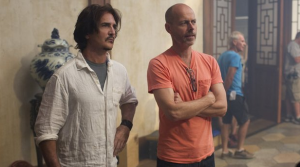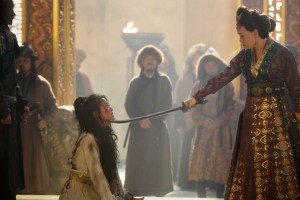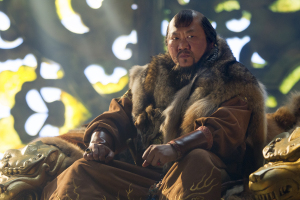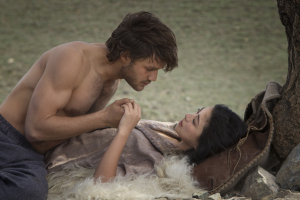
Marco Polo, the new Netflix original series about the years the Silk Road’s most famous traveler spent in the court of Kublai Khan, is a sweeping historical drama with the mettle of a Chinese martial arts film. According to creator and executive producer John Fusco, “the martial arts component and the rigorous stunt training all of the actors went through is really the heart and soul of this whole production,” beginning with its inception. “It really drove the creative in so many ways,” he said. “This isn’t some attempt to graft martial arts onto Marco Polo’s story just to make it cool. We’re talking 13th Century China here, and Kublai Khan, which many Westerners may not know, was all about collecting and maintaining the very best of Chinese culture. He surrounded himself with the best painters, the best calligraphers, the top ministers of warfare. There’s no doubt that Chinese martial arts were an essential part of this world.”
Fusco shares series showrunner duties with executive producer Dan Minahan, a first for both. Minahan, known for his work on Six Feet Under, True Blood, Homeland and Game of Thrones, also directed two of the first 10 episodes now available on Netflix. Marco Polo‘s rich, filmic look was digitally acquired in 4K on the Sony F55 and cut on Avid.
The series also marks Harvey Weinstein and The Weinstein Company‘s first major push into scripted cinematic television. “Right from the very beginning, Harvey was the driving force of this project,” said Fusco. “Harvey’s extremely knowledgable about Chinese cinema and he’s very interested in high quality martial arts cinema, particularly the works of King Hu and the Shaw brothers films from the 1950s – 70s. When he and I first talked about this project, he wanted to give this story the full martial arts treatment. The best part is it is completely organic to this story.”

Despite what we might have learned as children, Kublai Khan the barbarian in fact had a multi-ethnic court, deep cultural curiosity and religious tolerance; he was more a talented, empire-building CEO, said Fusco, than a slash-and-burn nomad like his grandfather Genghis Khan. The show’s equally diverse fight menu reflects what was practiced by both his court and armies, from 13th century Chinese Shaolin and Wudang temple martial arts traditions to Mongolian wrestling and swordplay. A single scene in a later episode, in fact, features three characters fighting in three distinct styles. “I really think that we handle the martial arts in a very respectful way that is not gratuitous,” said Fusco. “We push toward the Wuxia elements, those ‘martial hero’ Chinese literary and martial arts elements that are poetic and gorgeously athletic. This was a time when monks trained endlessly and their skill sets were just phenomenal. When you go back and read old combat manuals and they describe a certain fighter and what he was capable of doing, it became obvious that they could pretty much do high-wire Kung Fu without wires!” Like Game of Thrones, Marco Polo reveals plenty of skin, even in the service of martial arts. Olivia Cheng‘s character, in a high Tarantino moment, fights completely naked in one pivotal scene.
Marco Polo is not, however, peppered with bamboo-grazing flights of fancy. “We get into that a little bit but the martial arts are all practical, grounded and very real world,” said Fusco. “In fact, we kept all the visual effects as grounded in the practical as we could. VFX was only really used to augment, say to turn a team of 300 extras into a battlefield of thousands or an eight-foot wall into a towering edifice.”
 The intensely physical yet balletic movements required by high-level martial arts meant each fight scene be meticulously mapped out and the actors be in optimal shape before filming began. Fusco writes out all of his fight scenes and is deeply involved in the choreography. He hired fight coordinator and choreographer Brett Chan (X-Men 2, The Last Samurai, The Twilight Saga: Breaking Dawn Pt. 2, ) to put together a stunt camp featuring hours of “very hard core conditioning and circuit training,” said Fusco. “I was with them every morning and participated in those sessions,” he explained. “Everyone had to train and they had to train quickly.” A team of Chinese, Japanese and Bulgarian stunt men, including Jet Li‘s famed body double Ju Kun, joined the training in January. Then tragedy struck, and Kun and 238 others vanished on Malaysian Airlines Flight 370 in early March. “When that happened, it pulled the stunt team and the whole Marco Polo family much tighter together,” he said.
The intensely physical yet balletic movements required by high-level martial arts meant each fight scene be meticulously mapped out and the actors be in optimal shape before filming began. Fusco writes out all of his fight scenes and is deeply involved in the choreography. He hired fight coordinator and choreographer Brett Chan (X-Men 2, The Last Samurai, The Twilight Saga: Breaking Dawn Pt. 2, ) to put together a stunt camp featuring hours of “very hard core conditioning and circuit training,” said Fusco. “I was with them every morning and participated in those sessions,” he explained. “Everyone had to train and they had to train quickly.” A team of Chinese, Japanese and Bulgarian stunt men, including Jet Li‘s famed body double Ju Kun, joined the training in January. Then tragedy struck, and Kun and 238 others vanished on Malaysian Airlines Flight 370 in early March. “When that happened, it pulled the stunt team and the whole Marco Polo family much tighter together,” he said.
“We of course had to be very careful shooting all these fight scenes, but we always played to people’s strengths,” added Minahan. “Tom Wu, who plays Hundred Eyes, is already a martial arts competitor; Olivia Cheng (Mei Lin) is a former gymnast. We really encouraged the cast to take the workout regimen seriously so they didn’t get injured. For many it was the opportunity of a lifetime to train to use a long sword and do Kung Fu.”
With a reported $90 million budget and filmed on location in Venice, Malaysia and in remote Kazakhstan, Marco Polo in many ways more closely resembles a mid-level Hollywood film or a blockbuster cable series like HBO’s Game of Thrones, the obvious inspiration for this project’s scope and meticulously wrought production values. (The budget for Game of Thrones’ first season, by comparison, was reportedly $50-60 million.) Marco Polo’s production stats are legion: a 160-person art department and 400-person construction and craftsman crew who designed, built, carved and dressed fifty-one separate sets out of 130 tons of plaster and 1.6 tons of silicone, and also forged ancient metal weapons from scratch; a large and experienced on-set production crew with both film and high-profile television credits; and hundreds of extras, including some 300 Kazakh horsemen who were authentically armored for battle and multiplied via digital effects into Khan’s thousands-strong army.
 The large international cast, almost all of Asian descent, seem chosen as much for their prior film and television credits as for their potential crossover appeal. Remy Hii (Prince Jingim) and Mahesh Jadu (Ahmad) are already television stars in Australia, where Netflix will roll out its streaming service in early 2015. Italian Lorenzo Richelmy is a relative newcomer in the title role alongside seasoned actors Benedict Wong (Kublai Khan), Joan Chen (Empress Chabi), Olivia Cheng (Mei Lin), Chin Han Jia Sidao), Tom Wu (Hundred Eyes), and Zhu Zhu (Kokachin), a triple-threat celebrity in her native China.
The large international cast, almost all of Asian descent, seem chosen as much for their prior film and television credits as for their potential crossover appeal. Remy Hii (Prince Jingim) and Mahesh Jadu (Ahmad) are already television stars in Australia, where Netflix will roll out its streaming service in early 2015. Italian Lorenzo Richelmy is a relative newcomer in the title role alongside seasoned actors Benedict Wong (Kublai Khan), Joan Chen (Empress Chabi), Olivia Cheng (Mei Lin), Chin Han Jia Sidao), Tom Wu (Hundred Eyes), and Zhu Zhu (Kokachin), a triple-threat celebrity in her native China.
Minihan said the decision to bring in Joachim Rønning and Espen Sandberg, the Norwegian directors of Kon-Tiki and the next Pirates of the Caribbean film, to direct the first four episodes, came from TWC executives and Harvey Weinstein. “It just seemed like a perfect fit; they have a great sense of adventure and Kon-Tiki is such a gorgeous film,” he said.
Minihan hand-picked the rest of the directors from those he greatly admired or had worked with before. “I tried to almost cast them with the right episode. For example, Alik Sakharov (The Sopranos, Game of Thrones) is a world-class cinematographer-turned-director and I knew he would be the perfect director to follow up Joachim and Espen because he’s so self-reliant. He could shoot the show himself if he needed to.” Minahan directed episodes 5 and 6, then passed the baton to David Petrarca (Big Love, Smash, True Blood), who came to the set with both television and theater experience. “One of his episodes was very intimate, so as a theater director, I thought he could really sink his teeth into that.” Minahan tapped John Maybury, who directed several episodes of HBO’s Rome, for the season finale. “Frankly, what he did on that show was some of the best stuff I’ve ever seen done on television,” Minahan said.
Controlling the sharp, equatorial light of the Malaysian sun and keeping the visual thread consistent from one director and cinematographer to the next was challenging enough, said Minahan. The greater hurdle was delivering a complete series to Neflix all at once, given the compressed production schedule that came with it. “I wanted to strive for the same type of visual identity for this show, and to do that, I worked with Joachim and Espen to make a bible for the show that was sort of a guide for the other directors,” he said. “We couldn’t do the first hour and have the luxury to stop and think about it.” Instead, he encouraged every director to keep up with the collective tone by watching each other’s dailies (provided by Encore Hollywood on Colorfront‘s mobile Express Dailies). This also encouraged a collegial exchange on set, he said, especially among the cinematographers.
“There is an amazing, untapped story here,” added Fusco. “Most other projects about Polo and Kublai Khan only tapped the surface. How can we not get excited about all of this? We really haven’t seen the sheer beauty, tradition, power and mystique of it all on television before.”





